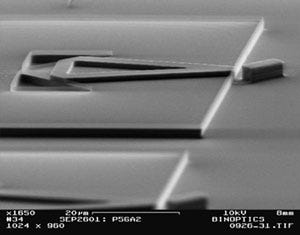Startup's strange ring laser promises to boost performance and cut the cost of a wide range of subsystems
November 21, 2002

Few in the industry have heard of components startup BinOptics Corp., but that could be about to change.
BinOptics is about to remove its stealth shield, says founder and CEO Alex Behfar, and he has given Light Reading an exclusive preview of what the company has to offer.
In a nutshell, BinOptics has some unusual laser technology that promises to boost the performance and slash the cost of a wide variety of subsystems. Its first product aims to enable 10-Gbit/s transmissions in coarse wavelength-division multiplexing (CWDM) systems -- four times current data rates.
That’s just for starters, according to BinOptics, which was founded in 2000. The applications for its so-called ring laser go way beyond pepping up CWDM systems.
So what exactly is a ring laser? Well, it gets its name because light can travel in either direction around a closed loop, although the actual laser is triangular in shape. Ring lasers achieve very high performance, claims Behfar, especially in terms of high output powers and side mode suppression ratio (SMSR) -- good suppression of signals other than the primary lasing wavelength. And they are easier to integrate than Distributed Feedback (DFB) Lasers and similar types of laser, like DBRs (distributed Bragg reflectors), he contends.
Ring lasers achieve very high performance, claims Behfar, especially in terms of high output powers and side mode suppression ratio (SMSR) -- good suppression of signals other than the primary lasing wavelength. And they are easier to integrate than Distributed Feedback (DFB) Lasers and similar types of laser, like DBRs (distributed Bragg reflectors), he contends.
The high performance is due to the way light is reflected by the cavity. Ordinary lasers need anti-reflection coatings to ensure high reflectivity at the ends of the cavity (see Laser Basics). Ring lasers use a different mechanism -- total internal reflection at the corners of the triangle, which can be 100 percent effective without any coatings.
Of course, some light needs to exit the cavity, and this is achieved by designing a sharp angle at one corner, so that light strikes the interface at an angle less than the critical angle. At angles just under the critical angle, the amount of reflection is still high, however.
"You can modify the reflectivity by changing the angle at the apex," Behfar says. This gives an advantage over ordinary lasers because "it gives you another knob you can play with in optimizing these interfaces."
One potential drawback is that two beams of light are created -- one for each direction around the ring. But BinOptics has invented a way of folding one of the beams of light back into the cavity, so that the energy is not wasted.
Work on this type of laser started more than 12 years ago, when Behfar was a doctoral student with Prof. Joseph Ballantyne at Cornell University in Ithaca, N.Y. After completing his thesis, Behfar went off to work at IBM Corp. (NYSE: IBM), but in the meantime Ballantyne's group continued to develop ring lasers and methods of integrating them with other components. Behfar returned in 2000, helping to found BinOptics to commercialize the technology coming out of Cornell.
Whether the ring laser is easier to integrate than DFBs seems debatable. Behfar says it is, because etching rather than cleaving of the wafer is used to define individual components. That means components can be physically and thermally separate from one another. Light can travel through space between components rather than always having to travel by waveguide.
Other startups don't see any problems with integrating DFBs or similar types of laser. Agility Communications Inc., for example, has integrated a tunable DBR laser, a modulator, and an amplifier on the same chip, to target DWDM applications (see Agility Packs Three Into One).
BinOptics is unlikely to compete directly with Agility for the time being because it is targeting cost-sensitive applications in the first instance. But it may compete in the future, because DWDM laser arrays are also on the startup's road map.
BinOptics is kicking off its product range with a 10-Gbit/s electroabsorption modulated laser (EML) for CWDM applications, which integrates a ring laser, a modulator, and a photodiode for monitoring the optical output. The company claims that its technology platform enables integration at a very attractive price, which is important in an application like CWDM.
The EML has been prototyped and shipped to the first customer already. Behfar declined to provide a price, but did say that integrating three components typically saves more than 50 percent compared to the cost of packaging the components separately.
He acknowledges that other components manufacturers already produce similar modules that incorporate multiple elements in a single package. But, he contends, doing the integration monolithically makes life much simpler (i.e., cheaper), because the elements are already perfectly aligned.
Vendors of CWDM transmitters include Finisar Corp. (Nasdaq: FNSR), Luminent Inc., and Tsunami Optics. However, in terms of the technology platform, BinOptics may also end up competing with startups such as ASIP Inc., which also claims to have a low-cost, high-yield integration platform (see Startup Has an 'Uncool' Laser ).
BinOptics has raised an undisclosed amount of funding from Draper Fisher Jurvetson.
— Pauline Rigby, Senior Editor, Light Reading
www.lightreading.com
You May Also Like








